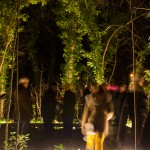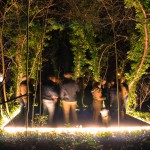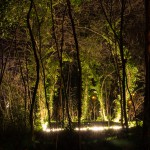
Art is a funny way to communicate. As a young artist, I spend my days finding ways to communicate what I want to say about the world through my artistic practise.
Recently I got very interested in people’s relationship to the land. I’ve been thinking about how we claim land, say it’s ours, use it, change it and manipulate it to suit our wants and needs. Building, landscaping, decorating, lighting, putting up fences, patrolling the borders, there’s a myriad of possibilities. It’s interesting to see how people think about land as property, how they create safe spaces for themselves in which they can control things, what mechanisms they use to keep the unwanted off their land and the cherished inside to protect and keep close.
I’ve been thinking how we claim land, say it’s ours, change it to suit our wants and needs
I try to make artworks that aren’t objects but experiences, works that can be experienced but not sold. They are conceived and built for specific pieces of land and I try to tune in to the history and current situation of that place when I make them. For example, a few weeks ago I had an exhibition that lasted just one evening. It took place on a wasteland in the middle of my hometown of Mol, in Belgium. It’s almost the only piece of land in town that hasn’t had anything built on it, and over the years a young forest has grown there. The fences have fallen down, chickens have escaped from the market and taken up residence in the trees, people feed them sandwiches and spaghetti. Some of the space is used to park cars, some of it’s turned into a forest and is used as a shelter for more dodgy activities, and people dump their trash there. It’s a place to avoid at night, and to ignore in daylight, but the ecosystem that’s developed there is quite lovely, and the way people have claimed back this space, that is actually private land but wasn’t being used, is very telling.
My work on that wasteland consisted of a 4,5 x 4,5m square made of lights, facing outwards. Visitors had to make their way through the forest, step over the lights and into a square cleared of everything that could sting or make you stumble. From inside the square you could see the surroundings very clearly. A drink in your hand and the company of other people made an evening on a wasteland less disturbing.
A very simple artwork brought about an impressive transformation in that place. The ivy crushed under many feet gave off a heady smell and the arch of ivy-covered trees above our heads demanded more attention that it normally would. The background was taken out of the scene by lighting up only the foreground details, like the young buds on the trees, revealing details we wouldn’t normally see. The experience gave us an entirely different perspective on a place we walk past often in our daily lives.
I think we need art to challenge us to rethink our perspective. As an artist and young explorer I will keep trying to build a critical artistic practise, exploring the way people experience and relate to the natural world.



